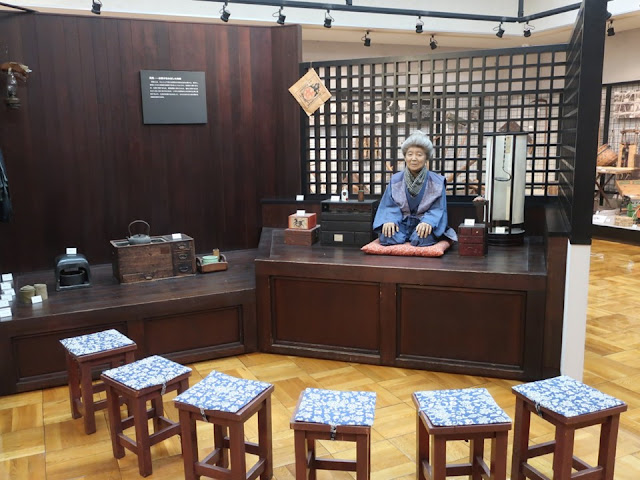The museum is at Matsumoto basin in Nagano prefecture of central Japan, which shows us its folklore and history. There is as exhibition room in the second floor; there is a soba noodle restaurant in the first floor.
松本市西部の梓川地区の民俗や歴史を紹介する資料館です。上高地から流れてきた清流・梓川の左岸です。展示室は2階、1階には美術ギャラリーや甘味も食べられる蕎麦屋さんがあります。
Folklore exhibition room、民俗の展示室
Agricultural equipment are exhibited. A article of a historian (Naramoto Tatsuya, 1913-2001) is quoted on the panel behind the machine which made a straw rope. He wrote, “The farmers’ lifestyle when he was a child was almost same as the one in the Edo period (1603~1868)”. It was before the spread of electric motors.
農機具の展示:縄をなう機械の後ろに歴史学者・奈良本辰也さん(1913ー2001)の説明パネルがあります。彼が幼かった頃の農民たちの暮らしは、「江戸時代以来、ほとんど変わらなかったような印象を受けた」そうです。電動機が普及する前でした。
Equipment for sericulture are displayed. Most of museums in Nagano prefecture display them.
信州の資料館では養蚕業の展示は欠かせません。
Everyday goods are also displayed tidily.
さまざまな日用品が展示されています。
The bamboo ladle was used to warm up soba noodle. It’s a cold area, so people warm it up just before eating. Duck meat, mushrooms and vegetables are simmered together in a pot. The meal is named “Touji-soba”, which is my favorite.
蕎麦のしゃぶしゃぶともいわれる「とうじ蕎麦」(右下、松本市奈川地区の仙洛さん)に使われる「とうじかご」も展示されています。鴨肉ときのこや野菜を煮た鍋でそばを温めます。寒冷地なのでそばを温めたというのですが、とても美味しくおすすめです。
Lunch boxes are exhibited. The one in front is breathable, so was used in summer. I don’t know what “Yudaru” is; I just guess it was used to boil water while lunch.
通気性がよい夏用(手前)などさまざまな弁当箱が展示されています。右端は、「湯だる」という品物。弁当の時に湯を沸かしたのでしょうか。
Traditional and simple toys are exhibited; the flat dolls are particular to Matsumoto basin. If children didn't know video games, it would be enough for them to enjoy pastime.
松本平特有の押し絵雛(上)や子供たちのおもちゃ。素朴なものですが、これで十分楽しめますね。
The robot of an old woman tells us events in the past such as charcoal fueled car broke down easily. She was born in 1921 and speaks in dialect. I unintentionally stopped and listened to her talk.
1921年生まれのお婆ちゃんロボットがエンコする木炭車など昔の生活を方言で語ってくれます。つい聞いてしまいますね。
History exhibition room、歴史の展示室
Villagers have gotten plenty of gifts from Azusa River. They enshrine “Azusa-mizu(water) great deity” as their guardian in Ohmiya Atsuta Shrine.
梓川の恩恵を受ける里々では「梓水大神」を守護神とし、大宮熱田神社に祀りました。
I visited the shrine two days later. There are three sacred trees. The tree on the left is named “Tree of longevity”. The giant fir tree in center is designated as a natural monument. Giant trees grow in the shrine; it should be a so-called “power spot” (spiritual energy sites), I think.
翌々日に神社へ参拝しました。資料館に大きな写真が展示されている天然記念物のモミ(鳥居右側)は見事な巨木ですが、左側の「長生きの木」、「縁結び仲良しの木」(右側の写真)の三本のご神木がありました。巨木が育つのですね。パワースポットだと思います。
Visited in November, 2023
Official website: http://www.azusagawa-akademia.jp/ (in
Japanese), accessed in July, 2024
Previous post (museum in a neighboring city): Matsumoto city Azumi museum、松本市安曇資料館
Next post (museum in a famous farm of the neighboring city): Daio Wasabi Farm & Centennial Memorial Hall、大王わさび農場と百年記念館










Comments
Post a Comment